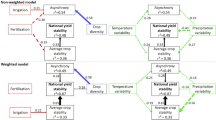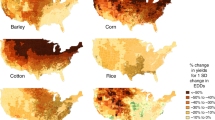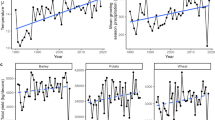Abstract
Food production stability against climate variability and extremes is crucial for food security and is influenced by variations in planted area, harvested area and yield. Yet research has focused on yield responses to climate fluctuations, ignoring how planted area and harvestable fraction (that is, the ratio of planted area to harvested area) affect production stability. Here we apply a time series shock detection approach to county-level data (1978–2020) on seven crops in the United States, finding that shocks (that is, sudden statistically significant declines) in planted area and harvestable fraction co-occur with 51–81% of production shocks, depending on the crop. Decomposing production shock magnitudes, we find that yield fluctuations contribute more for corn (59%), cotton (49%), soybean (64%) and winter wheat (40%), whereas planted area and harvestable fraction have a greater role for others. Additionally, climatic variables explain considerable portions of the variance in planted area (22–30%), harvestable fraction (15–28%) and yield (32–50%). These findings demonstrate that crop production shocks are often associated with fluctuations in planted area and harvestable fraction. This highlights the (largely ignored) importance of producer decision-making about cropping patterns in stabilizing food production against climate variability and emphasizes the need to consider all three production components to improve food system stability.
This is a preview of subscription content, access via your institution
Access options
Access Nature and 54 other Nature Portfolio journals
Get Nature+, our best-value online-access subscription
$29.99 / 30 days
cancel any time
Subscribe to this journal
Receive 12 digital issues and online access to articles
$119.00 per year
only $9.92 per issue
Buy this article
- Purchase on Springer Link
- Instant access to full article PDF
Prices may be subject to local taxes which are calculated during checkout




Similar content being viewed by others
Data availability
All raw data are publicly available online. County-level harvested fraction, planted area, yield and production data for the US are available at https://www.nass.usda.gov/Quick_Stats/Lite/index.php. Climatic data from the PRISM database are available at https://prism.oregonstate.edu/. GP data are available at https://www.nass.usda.gov/Publications/Todays_Reports/reports/fcdate10.pdf.
Code availability
The R code for shock detection was derived from Gephart et al.29 (https://github.com/jagephart/Shock_Detection). The R code for the decomposition and the Python code for the random forest analysis are available at https://github.com/Dongyang2020/US_Shock.
References
World Food Programme. Global Report on Food Crises 2022 (GRFC, 2022); https://www.wfp.org/publications/global-report-food-crises-2022
Firdaus, R. R., Senevi Gunaratne, M., Rahmat, S. R. & Kamsi, N. S. Does climate change only affect food availability? What else matters? Cogent Food Agric 5, 1707607 (2019).
Schmidhuber, J. & Tubiello, F. N. Global food security under climate change. Proc. Natl Acad. Sci. USA 104, 19703–19708 (2007).
Food and Agriculture Organization. Food Security. Policy Brief (FAO, 2006); https://www.fao.org/fileadmin/templates/faoitaly/documents/pdf/pdf_Food_Security_Cocept_Note.pdf
Davis, K. F., Downs, S. & Gephart, J. A. Towards food supply chain resilience to environmental shocks. Nat. Food 2, 54–65 (2021).
Wheeler, T. & von Braun, J. Climate change impacts on global food security. Science 341, 508–513 (2013).
Lobell, D. B., Schlenker, W. & Costa-Roberts, J. Climate trends and global crop production since 1980. Science 333, 616–620 (2011).
Pacetti, T., Caporali, E. & Rulli, M. C. Floods and food security: a method to estimate the effect of inundation on crops availability. Adv. Water Res. 110, 494–504 (2017).
Allen, M. R. et al. in Special Report on Global Warming of 1 °C (eds Masson-Delmotte, V. et al.) (WMO, 2018).
Coumou, D. & Robinson, A. Historic and future increase in the global land area affected by monthly heat extremes. Environ. Res. Lett. 8, 034018 (2013).
Jones, A. W. & Phillips, A. Historic food production shocks: quantifying the extremes. Sustainability 8, 427 (2016).
Coumou, D. & Rahmstorf, S. A decade of weather extremes. Nat. Clim. Change 2, 491–496 (2012).
Robert, M., Thomas, A. & Bergez, J.-E. Processes of adaptation in farm decision-making models. A review. Agron. Sustain. Dev. 36, 64 (2016).
Iizumi, T. & Ramankutty, N. How do weather and climate influence cropping area and intensity. Glob. Food Sec. 4, 46–50 (2015).
Kotera, A., Nguyen, K. D., Sakamoto, T., Iizumi, T. & Yokozawa, M. A modeling approach for assessing rice cropping cycle affected by flooding, salinity intrusion, and monsoon rains in the Mekong Delta, Vietnam. Paddy Water Environ. 12, 343–354 (2014).
Beausang, C., Hall, C. & Toma, L. Food waste and losses in primary production: qualitative insights from horticulture. Resour. Conserv. Recycl. 126, 177–185 (2017).
Gunders, D. & Bloom, J. Wasted: How America Is Losing up to 40 Percent of Its Food from Farm to Fork to Landfill (Natural Resources Defense Council, 2017).
Leng, G. & Hall, J. Crop yield sensitivity of global major agricultural countries to droughts and the projected changes in the future. Sci. Total Environ. 654, 811–821 (2019).
Renard, D. & Tilman, D. National food production stabilized by crop diversity. Nature 571, 257–260 (2019).
Vogel, E. et al. The effects of climate extremes on global agricultural yields. Environ. Res. Lett. 14, 054010 (2019).
Zampieri, M., Weissteiner, C., Grizzetti, B., Toreti, A., van den Berg, M. & Dentener, F. Estimating resilience of crop production systems: from theory to practice. Sci Total Environ. 735, 139378 (2020).
Zipper, S. C., Qiu, J. & Kucharik, C. J. Drought effects on US maize and soybean production: spatiotemporal patterns and historical changes. Environ. Res. Lett. 11, 094021 (2016).
Ray, D. K., Gerber, J. S., MacDonald, G. K. & West, P. C. Climate variation explains a third of global crop yield variability. Nat. Commun. 6, 5989 (2015).
Rezaei, E. E., Ghazaryan, G., Moradi, R., Dubovyk, O. & Siebert, S. Crop harvested area, not yield, drives variability in crop production in Iran. Environ. Res. Lett. 16, 064058 (2021).
Lesk, C., Rowhani, P. & Ramankutty, N. Influence of extreme weather disasters on global crop production. Nature 529, 84–87 (2016).
Cohn, A. S., VanWey, L. K., Spera, S. A. & Mustard, J. F. Cropping frequency and area response to climate variability can exceed yield response. Nat. Clim. Change 6, 601–604 (2016).
Food and Agriculture Organization of the United Nations. FAOSTAT Statistical Database (FAO, 2022).
United States Department of Agriculture National Agricultural Statistics Service. Quick Stats Database (USDA NASS, 2022); https://www.nass.usda.gov/Quick_Stats/Lite/index.php
Gephart, J. A., Deutsch, L., Pace, M. L., Troell, M. & Seekell, D. A. Shocks to fish production: identification, trends, and consequences. Glob. Environ. Change 42, 24–32 (2017).
Ang, B. W. LMDI decomposition approach: a guide for implementation. Energy Policy 86, 233–238 (2015).
Savary, S. et al. Mapping disruption and resilience mechanisms in food systems. Food Secur. 12, 695–717 (2020).
Bebber, D. P. & Gurr, S. J. Crop-destroying fungal and oomycete pathogens challenge food security. Fungal Genet. Biol. 74, 62–64 (2015).
Xia, L. & Robock, A. Impacts of a nuclear war in South Asia on rice production in mainland China. Clim. Change 116, 357–372 (2013).
Aday, S. & Aday, M. S. Impact of COVID-19 on the food supply chain. Food Qual. Saf. 4, 167–180 (2020).
Brinkman, H.-J., de Pee, S., Sanogo, I., Subran, L. & Bloem, M. W. High food prices and the global financial crisis have reduced access to nutritious food and worsened nutritional status and health. J. Nutr. 140, 153S–161S (2010).
De Schutter, O. Report of the Special Rapporteur on the Right to Food. Final Report: the Transformative Potential of the Right to Food (A/HRC/25/57) (United Nations, General Assembly, Human Rights Council, 2014).
Fraser, E. D. G., Legwegoh, A. & Krishna, K. C. Food stocks and grain reserves: evaluating whether storing food creates resilient food systems. J. Environ. Stud. Sci. 5, 445–458 (2015).
Heslin, A. et al. Simulating the cascading effects of an extreme agricultural production shock: global implications of a contemporary US dust bowl event. Front. Sustain. Food Syst. https://doi.org/10.3389/fsufs.2020.00026 (2020).
Porkka, M., Kummu, M., Siebert, S. & Varis, O. From food insufficiency towards trade dependency: a historical analysis of global food availability. PLoS ONE 8, e82714 (2013).
Kearney, J. Food consumption trends and drivers. Philos. Trans. R. Soc. Lond. B Biol. Sci. 365, 2793–2807 (2010).
Marchand, P. et al. Reserves and trade jointly determine exposure to food supply shocks. Environ. Res. Lett. 11, 095009 (2016).
Suweis, S., Carr, J. A., Maritan, A., Rinaldo, A. & D’Odorico, P. Resilience and reactivity of global food security. Proc. Natl Acad. Sci. USA 112, 6902–6907 (2015).
Boyer, J. S. et al. The U.S. drought of 2012 in perspective: a call to action. Glob. Food Secur. 2, 139–143 (2013).
Herrero, M. et al. Innovation can accelerate the transition towards a sustainable food system. Nat. Food 1, 266–272 (2020).
Bowles, T. M. et al. Long-term evidence shows that crop-rotation diversification increases agricultural resilience to adverse growing conditions in North America. One Earth 2, 284–293 (2020).
Mahaut, L., Violle, C. & Renard, D. Complementary mechanisms stabilize national food production. Sci. Rep. 11, 4922 (2021).
Walker, B. et al. Response diversity as a sustainability strategy. Nat. Sustain. https://doi.org/10.1038/s41893-022-01048-7 (2023).
Field Crops: Usual Planting and Harvesting Dates. Agricultural Handbook 628 (USDA National Agricultural Statistics Service, 2010).
Guilpart, N., Iizumi, T. & Makowski, D. Data-driven projections suggest large opportunities to improve Europe’s soybean self-sufficiency under climate change. Nat. Food 3, 255–265 (2022).
Yang, Y. et al. Characterizing spatiotemporal patterns of crop phenology across North America during 2000–2016 using satellite imagery and agricultural survey data. ISPRS J. Photogramm. Remote Sens. 170, 156–173 (2020).
Ang, B. W., Huang, H. C. & Mu, A. Properties and linkages of some index decomposition analysis methods. Energy Policy 37, 4624–4632 (2009).
Breiman, L. Random forests. Mach. Learn. 45, 5–32 (2001).
Hoffman, A. L., Kemanian, A. R. & Forest, C. E. The response of maize, sorghum, and soybean yield to growing-phase climate revealed with machine learning. Environ. Res. Lett. 15, 094013 (2020).
Bergstra, J. & Bengio, Y. Random search for hyper-parameter optimization. J. Mach. Learn. Res. 13, 281–305 (2012).
Acknowledgements
This study was supported in part by the Gerard J. Mangone Climate Change Science & Policy Hub at the University of Delaware. K.F.D. acknowledges support from a USDA National Institute of Food and Agriculture grant no. 2022-67019-37180 and University of Delaware General University Research Fund.
Author information
Authors and Affiliations
Contributions
D.W. and K.F.D. conceptualized the study. D.W., J.A.G., T.I., N.R. and K.F.D. devised the methodology. D.W. validated and visualized the data. D.W. and K.F.D. wrote the original manuscript draft. D.W., J.A.G., T.I., N.R. and K.F.D. reviewed and edited the manuscript.
Corresponding author
Ethics declarations
Competing interests
The authors declare no competing interests.
Peer review
Peer review information
Nature Sustainability thanks the anonymous reviewers for their contribution to the peer review of this work.
Additional information
Publisher’s note Springer Nature remains neutral with regard to jurisdictional claims in published maps and institutional affiliations.
Supplementary information
Supplementary Information
Supplementary Tables 1–5 and Figs. 1–7.
Rights and permissions
Springer Nature or its licensor (e.g. a society or other partner) holds exclusive rights to this article under a publishing agreement with the author(s) or other rightsholder(s); author self-archiving of the accepted manuscript version of this article is solely governed by the terms of such publishing agreement and applicable law.
About this article
Cite this article
Wei, D., Gephart, J.A., Iizumi, T. et al. Key role of planted and harvested area fluctuations in US crop production shocks. Nat Sustain 6, 1177–1185 (2023). https://doi.org/10.1038/s41893-023-01152-2
Received:
Accepted:
Published:
Issue Date:
DOI: https://doi.org/10.1038/s41893-023-01152-2
This article is cited by
-
Where global crop yields may falter next
Nature Food (2024)
-
Alleviating water scarcity by optimizing crop mixes
Nature Water (2023)



